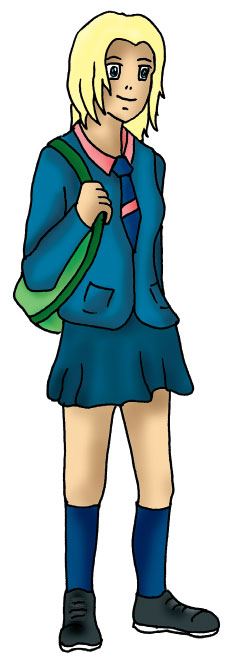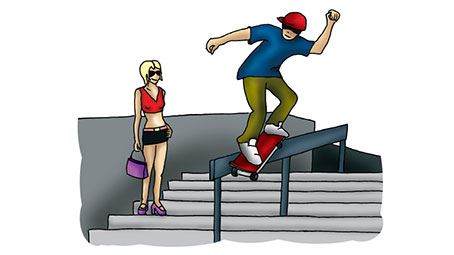FASHION
Are you worried about what to wear on the first day at school?
What is important for you when choosing your clothes?
Do you pick on other students if you don’t like their clothes? Why/Why not?
Do you think schools should have a uniform?
How much do you think the clothes we wear affect the way we behave?
Summer is over and it is that time again when we are getting ready for school. The fun part of starting school is that we can use back-to-school shopping as an excuse to buy some new clothes.
June Andrews, an exchange student from London, is starting high school in Baltimore, in the USA. She’s nervous, yet very excited about going to school and what to wear on the first day.
In England she had to wear the school uniform – a deep blue jacket and a skirt with a pink blouse and a matching[explanation: match – sobima, sobiv] tie[explanation: tie – lips]. Although they weren’t allowed to use accessories [explanation: accessories – lisand, aksessuaar]to show their own style, she wishes more schools had a dress code. The problem is that there’s a lot of peer pressure that makes it really hard to dress nicely. Not all kids can afford [explanation: afford – (enesele) lubama, võimaldama]to keep up with[explanation: keep up with – sammu pidama, kursis olema] the new fashions. Lots of young people in Britain complain[explanation: complain – kaebama, kurtma] that if you don’t have the right pair of trainers you are bullied and if you have really expensive ones they will be stolen.
When June thinks of school fashion in general[explanation: general – üldine], she pictures tons of T-shirts matched with jeans and flip flops[explanation: flip flops – lahtine sandaal, plätu]. This is, actually, a school trend [explanation: trend – mood, hoiak, suundumus]she doesn’t want to go along with anyway. She says that she may not be the most fashionable [explanation: fashionable – moodne, moekas, peen]person and her goal is not to compete with the other girls; however, she definitely [explanation: definitely – kindlalt, täpselt]wants to stay as chic [explanation: chic – šikk]as she possibly can be in an American high school.
The fact is that fashionable clothes at school can cause competition and fight between students. Teenagers already have enough pressure on them. The pressure on students to wear designer [explanation: designer – moelooja, disainer]clothes is silly. We shouldn’t decide about people by what they wear. It is believed that uniforms level [explanation: level – tasandama, ühtlustama]the playing field among students from different economic [explanation: economic – majanduslik]backgrounds.
Different gangs[explanation: gang – jõuk, kamp] identify [explanation: identify – samastuma; identifitseerima]themselves by wearing certain clothes, colours and symbols, that is why baggy [explanation: baggy – kottis, lotendav]trousers and sweatshirts[explanation: sweatshirts – dressipluus] are not allowed in some American schools. Some schools have also banned [explanation: ban – keelustama]jeans with low waists [explanation: waist – piht, talje]and T-shirts that show your tummy[explanation: tummy – kõhuke]. More and more schools in the United States are making students wear uniforms. School is considered a place for concentration and study; therefore, students should wear simple clothes.
June thinks fashion and image are very important to teenagers. Their clothes are a way for them to express their personalities. It’s a healthy way to be creative[explanation: creative – loominguline]. She is sure that the clothes we wear don’t change the way we study at school. Putting on a tie doesn’t make someone any more intelligent.
June doesn’t think that fashion is the most important thing in our lives, however. It’s not wise to waste your time looking in the mirror and worrying about your looks [explanation: looks – inimese välimus, ilu]– better look into your books and learn something new. If you want to look like a pop star, you can do so after school. Personality is more important than looks.
NOTES


Exercises
Exercise 1.1
Read the questions, then choose the best answer a, b or c. Find the part of the text which helps you find the answer.
1. Why is June Andrews nervous?
a. Because she’s from London.
b. Because she’s going to school in the USA.
c. As an exchange student she’s excited about what to wear.
2. Why does she wish more schools should have a dress code?
a. Because accessories are allowed.
b. Because not all kids can afford to keep up with new fashions.
c. Because she had to wear the school uniform.
3. What does June think of school fashion in general?
a. She pictures tons of T-shirts matched with jeans and flip flops.
b. She thinks school trends should be fashionable.
c. In general, school fashion is chic.
4. What is believed about uniforms?
a. They can cause competition and fights between students.
b. They level the playing field among students from different economic background.
c. Wearing uniforms is silly.
5. Why are more and more schools in the United States making students wear uniforms?
a. Because school is considered a place for concentration and study.
b. Because some T-shirts show your tummy.
c. Because lots of students wear baggy trousers and sweatshirts.
6. What is more important than looks for June?
a. Being creative.
b. Being healthy.
c. Your personality.
Exercise 1.2
Copy the table and write down as many positive and negative ideas about wearing a school uniform from the text. Can you add your own ideas?

Exercise 1.3
Choose three ideas from the previous exercise and the text for why students should and why they needn’t wear a school uniform. Talk about your ideas. Use the linking words and phrases. There's no model.
Firstly, there’s a lot of peer pressure …
Secondly, not all kids …
In addition to this, it is believed that uniforms …
On the other hand, fashion is …
What’s more, clothes are a way …
Last but not least, putting on a tie …
Exercise 1.4
Look at the picture. Do you think the students in this picture go to the same school? What makes you think so? Describe the students in the picture. What are they wearing? Add some ideas about dress code from the previous exercise. Follow the model.

I can see … in the picture. I think they go to the same school because … .
One of them is wearing … .
In some schools students have to … . I think that wearing … . In my school, we … .
It’s … because … .
WWW * Exercise 1.5
In the song Sk8er Boi the girl doesn’t go out with the boy.
Listen to the song and say why.

GRAMMAR
PRESENT FORMS
PRESENT SIMPLE
The present simple is used:
• for repeated actions or habits especially with frequency adverbs: always, usually, often, sometimes, seldom, rarely, never, every day, etc.
Ben has a shower every morning.
Do you watch TV in the evenings?
What time does Jane finish work?
• for situations which are permanent, i.e. continue for a long time.
Mr Brown lives in Liverpool.
Kate’s parents work at a hotel.
• for general truths and laws of nature.
The sun rises in the east.
Elephants don’t eat meat.
• for timetables and programmes (future meaning).
The last train to London leaves at 10.45 p.m.
What time does the film start?
Time expressions used with the present simple:
always, usually, often, sometimes, seldom, never, every day/week/month/year, etc.,
in the morning/afternoon/evening, at night, at the weekend, on Sundays, etc.
Exercises
Exercise 1.6
Form negative sentences.
1. Mary works hard.
Mary doesn’t work hard.
2. We go to school every day.
3. Mark has to practise the piano every afternoon.
4. I speak Spanish.
5. My aunt has a cat.
6. You’re right.
7. Henry lives in Estonia.
8. They have breakfast at 7 a.m.
9. My sister marries a farmer.
10. I’m afraid of spiders.
Exercise 1.7
Form positive sentences.
1. This kite doesn’t fly well.
This kite flies well.
2. Meg doesn’t wish to see us.
3. The students don’t have their lunch in the canteen.
4. Stella and Greg don’t play tennis.
5. Tim doesn’t have breakfast every morning.
6. She isn’t fond of dogs.
7. My mum doesn’t worry about me.
8. Mr Creakle doesn’t go to Egypt.
9. We don’t have to buy these books.
10. My dog doesn’t lie in the garden.
Exercise 1.8
Add the frequency adverb in brackets to the sentence.
1. Bob is on time for class. (always) Bob is always on time for class.
2. Bob comes to class on time. (always) Bob always comes to class on time.
3. Ann is late for class. (oft en)
4. Ann comes to class late. (oft en)
5. Ron drinks coffee. (never)
6. He drinks tea. (sometimes)
7. I’m at home in the evenings. (usually)
8. I stay at home in the evenings. (usually)
9. Mary goes to the library. (seldom)
10. Mary is at the library in the evening. (seldom)
Exercise 1.9
Write at least five sentences about your habits. Use the frequency adverbs. For example:
I wear blue jeans every day.
Exercise 1.10
Complete the questions.
1. The children go to school in the morning.
Where ... the children go ... ?
When ... the children go ... ?
Who ... ?
2. Harry’s dog eats meat.
What ... Harry’s dog ... ?
Whose dog ... ?
Who ... ?
3. The kid’s grandparents live in the country.
Where ... the kid’s grandparents live?
Whose grandparents ... ?
Who ... ?
4. June Andrews has to wear a uniform at school.
What ... June Andrews have to ... ?
Where ... June Andrews ... ?
Who ... ?
